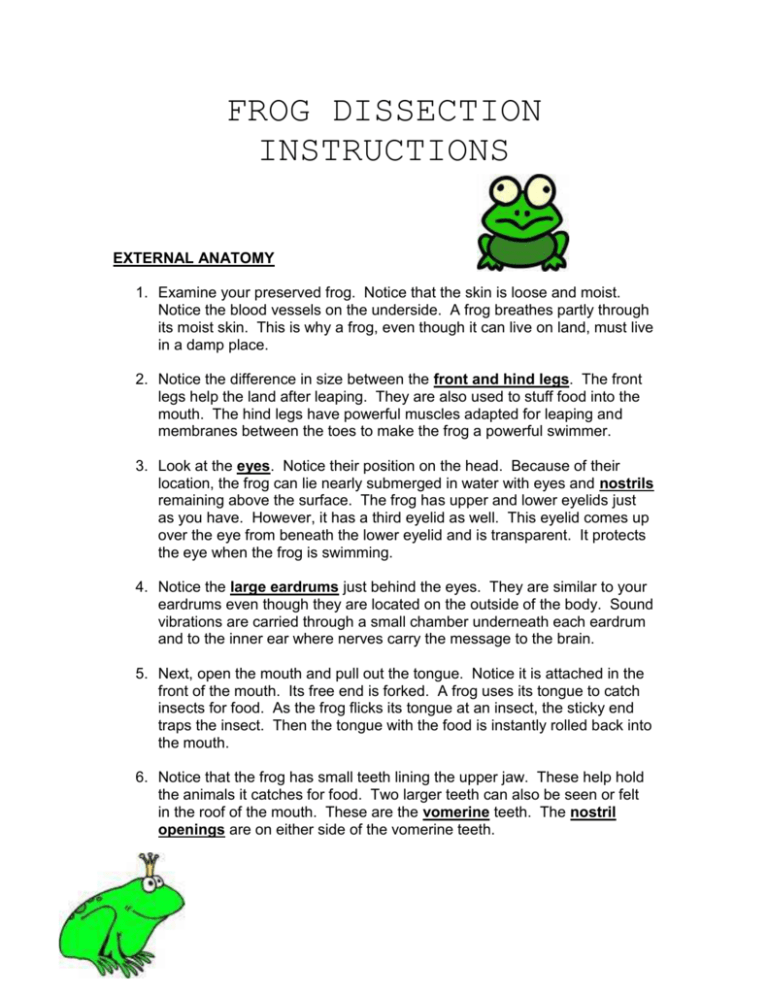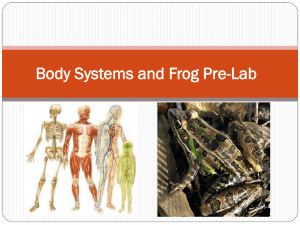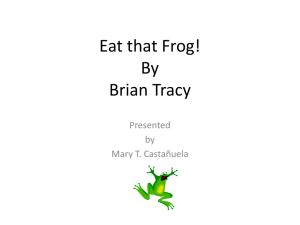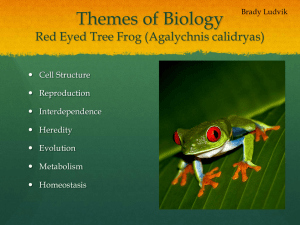FROG DISSECTION INSTRUCTIONS EXTERNAL ANATOMY
advertisement

FROG DISSECTION INSTRUCTIONS EXTERNAL ANATOMY 1. Examine your preserved frog. Notice that the skin is loose and moist. Notice the blood vessels on the underside. A frog breathes partly through its moist skin. This is why a frog, even though it can live on land, must live in a damp place. 2. Notice the difference in size between the front and hind legs. The front legs help the land after leaping. They are also used to stuff food into the mouth. The hind legs have powerful muscles adapted for leaping and membranes between the toes to make the frog a powerful swimmer. 3. Look at the eyes. Notice their position on the head. Because of their location, the frog can lie nearly submerged in water with eyes and nostrils remaining above the surface. The frog has upper and lower eyelids just as you have. However, it has a third eyelid as well. This eyelid comes up over the eye from beneath the lower eyelid and is transparent. It protects the eye when the frog is swimming. 4. Notice the large eardrums just behind the eyes. They are similar to your eardrums even though they are located on the outside of the body. Sound vibrations are carried through a small chamber underneath each eardrum and to the inner ear where nerves carry the message to the brain. 5. Next, open the mouth and pull out the tongue. Notice it is attached in the front of the mouth. Its free end is forked. A frog uses its tongue to catch insects for food. As the frog flicks its tongue at an insect, the sticky end traps the insect. Then the tongue with the food is instantly rolled back into the mouth. 6. Notice that the frog has small teeth lining the upper jaw. These help hold the animals it catches for food. Two larger teeth can also be seen or felt in the roof of the mouth. These are the vomerine teeth. The nostril openings are on either side of the vomerine teeth. INTERNAL ANATOMY – please have your coloring sheet out for a reference. 1. Lay the frog on its back. Make an incision at the point where the legs meet and cut the skin to the lower jaw. Make two more incisions to make the letter “I”. Examine the lower side of the skin and note the pattern of blood vessels. Study the muscle layers exposed by the removal of the skin. Picture of incision pattern here on class copy of instructions 2. Next, cut along the same lines cutting through the muscle. Incisions should be shallow as to not cut through the organs. Continue cutting through the sternum (chest bone) to the jaw to expose the heart. Finish your incisions making the letter “I”, and then pull back the muscle to expose the first layer of internal organs. 3. If your specimen happens to be female, the body cavity may be filled with eggs. These will have to be removed before you go any further. The eggs are loose in the cavity. You will also find two long coiled white oviducts leading from the anterior (front) end of the body cavity to the posterior (back) end. These are the tubes through which the eggs pass. 4. The first layer of organs that you will see is the LIVER (three lobes), THREE CHAMBERED HEART, STOMACH, FAT BODIES, and INTESTINES. 5. Carefully cut the liver out and place on your paper towel. Between two of the lobes you will see a small pea colored and shaped organ. This is the GALL BLADDER. The LIVER makes bile and the gall bladder stores bile. Bile is important in digestion. 6. Remove the STOMACH. It is a white organ below the liver. Open the stomach by cutting lengthwise and spread open to see if you can identify any food you find there. Notice the muscle layer that makes up the stomach wall. Is it smooth or rough? The stomach digests food both mechanically (mixing) and chemically (enzymes). Your stomach is also very thick walled to help protect the other parts of your body from the strong acid in the stomach. 7. Remove the SMALL INTESTINES (looped and long – used to absorb nutrients), the LARGE INTESTINE (short and wide – used to remove water from waste product), and the CLOACA (below the large intestine between the hind legs). Undigested foods, urine, and sperm or eggs leave the body through an opening, the anus, at the end of the cloaca. 8. Are there any yellow, banana shaped organs? These are FAT BODIES. They are stored food that the frog uses during hibernation. Remove them now. 9. Now you are ready to locate the second level of organs. You will find the heart, lungs, male or female organs, and kidneys. 10. Just beneath the jaw, below the sternum is the HEART (about the size of the end of your pinky finger). It has three chambers and arteries and veins to carry the blood throughout the body. It has two auricles (top) and one ventricle (bottom). Your heart has four chambers - two auricles and two ventricles. For the frog, blood coming through veins from the body (except the lungs) collects in the right auricle. Blood coming from the lungs collects in the left auricle. Both auricles contract and the blood is forced into the ventricle. Then the ventricle contracts and the blood is forced through the arteries to all parts of the body. Remove the heart now. 11. The RESPIRATORY SYSTEM includes the frog’s moist skin, with its very heavy supply of blood vessels and the LUNGS. The lungs are grayish organs on either side of the heart. As a tadpole the frog has gills. Remove the lungs. You breathe by raising and lowering your diaphragm. A frog does not have a diaphragm. All of the internal organs in the frog are in one large cavity (opening). 12. The REPRODUCTIVE SYSTEM in the male includes the TESTES and its ducts. The reproductive cells, sperm, are formed in the testes. The two testes are small, oval and yellow or yellow-white in color and are located just above the kidneys. They are sometimes attached to both the fat bodies and the kidneys. The OVARIES of the female are approximately in the same location as the testes in the male. In the spring, when the eggs are to be laid, these become large with eggs. At other times of the year, the ovaries may be small and difficult to find. Both sperm and eggs travel through tubes that empty into the cloaca. In the spring of the year, the female lays her eggs in the water. The male deposits sperm over them as they are being laid (external fertilization). After a short time, the fertilized eggs hatch into tadpoles, which eventually become adult frogs. 13. The EXCRETORY SYSTEM consists mainly of the KIDNEYS. These organs are dark red and lie one either side of the backbone. They are specialized to remove nitrogen wastes from the blood stream. These wastes dissolved in water become urine. From the kidneys, the urine goes through tubes into the urinary bladder and from there to the cloaca. From here is passes through the anus to the outside of the body. 14. Dissection of the BRAIN. Turn the frog over so that the dorsal side is up. Insert the point of your scissors through the skin at the base of the head and make an incision forward to the tip of the jaw. Remove the skin from this area. With the scissors, cut through the top of the skull. Use extreme care not to cut too deep. Spread the bone apart to expose the brain. Find the following parts: olfactory lobes, cerebrum, optic lobes, cerebellum, and the medullas from front to back. Picture of brain parts here on class copies of instructions. Be sure to follow all clean up procedures. I hope you enjoyed learning about me.







